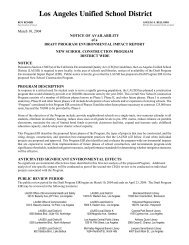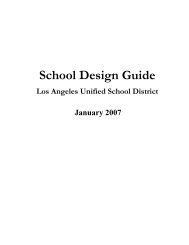Site-Specific Health and Safety Plan (HASP) - Laschools.org
Site-Specific Health and Safety Plan (HASP) - Laschools.org
Site-Specific Health and Safety Plan (HASP) - Laschools.org
You also want an ePaper? Increase the reach of your titles
YUMPU automatically turns print PDFs into web optimized ePapers that Google loves.
LAUSD Proposed South Region High School #9 & Middle School #4<br />
6-3<br />
December 2006<br />
<strong>Site</strong> <strong>Specific</strong> <strong>Health</strong> & <strong>Safety</strong> <strong>Plan</strong> (<strong>HASP</strong>)<br />
Task 4 – Borehole drilling <strong>and</strong> soil sampling: Subsurface sampling will be conducted using<br />
both a hollow-stem auger rig <strong>and</strong> a dual air percussion rig <strong>and</strong> split spoon samplers containing<br />
brass or stainless-steel tube liners. For the hollow stem auger method, drilling progresses by<br />
rotating the auger into the ground for one auger section, <strong>and</strong> withdrawing the auger, until<br />
reaching the final depth. The dual air percussion method involves hammering steal casing (or<br />
pipe) into the ground, <strong>and</strong> samples are also collected using spilt spoon samplers.<br />
For both methods, the split spoon samplers are driven into the subsurface deposits in advance of<br />
the drill bit. This is accomplished by dropping a 140-pound hammer from 30 inches (multiple<br />
repetetions) to completely embed the sampler (18 inches or 24 inches).<br />
Potential Hazards - Heavy equipment hazards from being struck by/against moving equipment<br />
<strong>and</strong> drill rigs; being caught <strong>and</strong> injured from moving equipment parts; lifting hazards from lifting<br />
<strong>and</strong> carrying materials; slip, fall, <strong>and</strong> trip hazards from walking on slippery <strong>and</strong> uneven surfaces;<br />
cuts, skin abrasions, <strong>and</strong> bruises from h<strong>and</strong>ling of sharp tools/objects; traffic safety hazards from<br />
working near operating vehicles <strong>and</strong> roadways; noise hazards from working near noise sources;<br />
excavation hazards (underground utilities) <strong>and</strong> overhead utilities hazard; noise hazards from<br />
working near a drill rig <strong>and</strong> other noise generating equipment; exposures to hazardous<br />
gases/vapor <strong>and</strong> particulates during drilling <strong>and</strong> sampling; <strong>and</strong> heat stress when working in a hot<br />
environment.<br />
Task 5 – Surveying: Surveying may involve a site visit, visual observations of the site features,<br />
identifying underground utilities or obstructions, <strong>and</strong>/or placing stakes/markers at survey points<br />
(i.e. drilling or sampling locations).<br />
Potential Hazards – Lifting hazards from lifting <strong>and</strong> carrying materials; slip, fall, <strong>and</strong> trip<br />
hazards from walking on slippery <strong>and</strong> uneven surfaces; traffic safety hazards from working near<br />
roadways <strong>and</strong> operating vehicles; cuts, skin abrasions, <strong>and</strong> bruises from h<strong>and</strong>ling of<br />
tools/objects; <strong>and</strong> heat stress when working in a hot environment.<br />
Task 6 – Underground Storage Tank Removal: Underground storage tank removal involves<br />
excavation to uncover the UST <strong>and</strong> associated piping, monitoring of combustible gases <strong>and</strong><br />
oxygen content using a combustible gas detector, removal/disposal of any residual liquid or<br />
sludge in the tank, decontamination <strong>and</strong> degassing of tanks <strong>and</strong> associated piping,<br />
washing/rinsing of tank, disconnecting/dismantling <strong>and</strong> removal of tank, backfilling of the tank<br />
with an inert solid such as concrete or grout (for in-place tank ab<strong>and</strong>onment only), soil sampling,<br />
backfilling of the excavation, <strong>and</strong> disposal/recycling of the tank.<br />
Potential Hazards - Heavy equipment hazards from being struck by/against moving equipment<br />
<strong>and</strong> mechanical parts; being caught <strong>and</strong> injured from moving equipment parts; lifting hazards<br />
from lifting <strong>and</strong> carrying materials; slip, fall, <strong>and</strong> trip hazards from walking on slippery <strong>and</strong>/or<br />
uneven surfaces or near open excavation; traffic safety hazards from working near roadways <strong>and</strong><br />
vehicles; cuts, skin abrasions, <strong>and</strong> bruises from h<strong>and</strong>ling of tools/objects; noise hazards from<br />
working near a excavator <strong>and</strong> other noise generating equipment; electrical hazards from<br />
improper use <strong>and</strong> h<strong>and</strong>ling of electrical devices; fire/explosion hazards from flammable<br />
gases/vapors in the tank; overhead hazards <strong>and</strong> excavation hazards (underground utilities <strong>and</strong><br />
unstable, loose soils/cave-ins); exposures to hazardous gases/vapor <strong>and</strong> particulates during<br />
excavation; exposure to hazardous gases/vapors during UST removal; <strong>and</strong> heat stress when<br />
working in a hot environment.<br />
194







